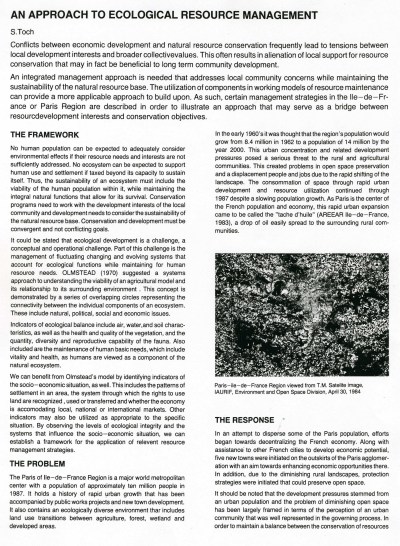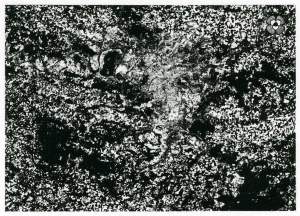An Approach To Ecological Resource Management
S. Toch
Conflicts between economic development and natural resource conservation frequently lead to tensions between local development interests and broader collective values. This often results in alienation of local support for resource conservation that may in fact be beneficial to long term community development. 
An integrated management approach is needed that addresses local community concerns while maintaining the sustainability of the natural resource base. The utilization of components in working models of resource maintenance can provide a more applicable approach to build upon. As such, certain management strategies in the Ile-de-France or Paris Region are described in order to illustrate an approach that may serve as a bridge between resource development interests and conservation objectives.
The Framework
No human population can be expected to adequately consider environmental effects if their resource needs and interests are not sufficiently addressed. No ecosystem can be expected to support human use and settlement if taxed beyond its capacity to sustain itself. Thus, the sustainability of an ecosystem must include the viability of the human population within it, while maintaining the integral natural functions that allow for its survival. Conservation programs need to work with the development interests of the local community and development needs to consider the sustainability of the natural resource base. Conservation and development must be convergent and not conflicting goals.
It could be stated that ecological development is a challenge, a conceptual and operational challenge. Part of this challenge is the management of fluctuating changing and evolving systems that account for ecological functions while maintaining for human resource needs. OLMSTEAD (1970) suggested a systems approach to understanding the viability of an agricultural model and its relationship to its surrounding environment. This concept is demonstrated by a series of overlapping circles representing the connectivity between the individual components of an ecosystem. These include natural, political, social and economic issues.
Indicators of ecological balance include air, water and soil characteristics, as well as the health and quality of the vegetation, and the quantity, diversity and reproductive capability of the fauna. Also included are the maintenance of human basic needs, which include vitality and health, as humans are viewed as a component of the natural ecosystem.
We can benefit from Olmstead's model by identifying indicators of the socio-economic situation, as well. This includes the patterns of settlement in an area, the system through which the rights to use land are recognized, used or transferred and whether the economy is accomodating local, national or international markets. Other indicators may also be utilized as appropriate to the specific situation. By observing the levels of ecological integrity and the systems that influence the socio-economic situation, we can establish a framework for the application of relevent resource management strategies.
The Problem
The Paris of Ile-de-France Region is a major world metropolitan center with a population of approximately ten million people in 1987. It holds a history of rapid urban growth that has been accompanied by public works projects and new town development. It also contains an ecologically diverse environment thar includes land use transitions between agriculture, forest, wetland and developed areas.
In the early 1960's it was thought that the region's population would grow from 8.4 million in 1962 to a population of 14 million by the year 2000. This urban concentration and related development pressures posed a serious threat to the rural and agricultural communities. This created problems in open space preservation and a displacement people and jobs due to the rapid shifting of the landscape. The consommation of space through rapid urban development and resource utilization continued through 1987 despite a slowing population growth. As Paris is the center of the French population and economy, this rapid urban expansion came to be called the "tache d'huile" (AREEAR Ile-de-France, 1983), a drop of oil easily spread to the surrounding rural communities.

Paris—ile-de—France Region viewed from T.M. Satelite image, IAURIF, Environment and Open Space Division, April 30, 1984
The Response
In an attempt to disperse some of the Paris population, efforts began towards decentralizing the French economy. Along with assistance to other French cities to develop economic potential, five new towns were initiated on the outskirts of the Paris agglomeration with an aim towards enhancing economic opportunities there. In addition, due to the diminishing rural landscapes, protection strategies were initiated that could preserve open space.
It should be noted that the development pressures stemmed from an urban population and the problem of diminishing open space has been largely framed in terms of the perception of an urban community that was well represented in the governing process. In order to maintain a balance between the conservation of resources.
| 